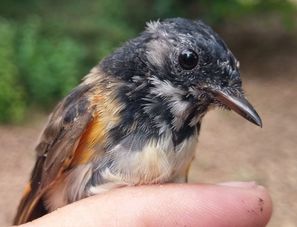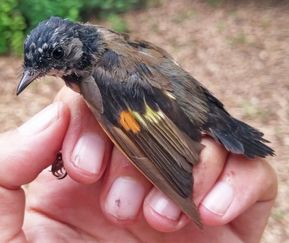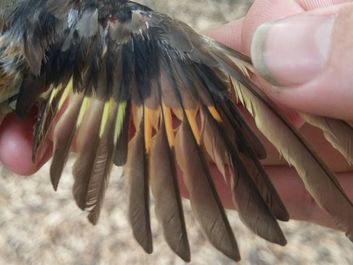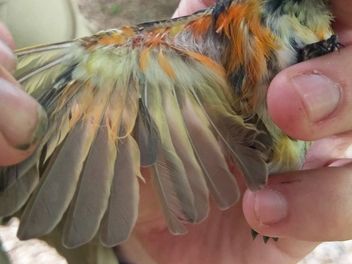Enjoying our blogs?Your support helps BSBO continue to develop and deliver educational content throughout the year.
|
|
Due to oncoming thunderstorms, rain, heat, and about 150% humidity, our MAPS banding operations at BSBO were cut short a little bit early today. From the little time we did band, however, we were able to gather that more young Yellow Warblers are on the move with their parents, there are already some completely molted (into formative plumage) hatching-year (HY) YEWAs roaming around on their own, and young Gray Catbirds are just starting to leave the nest, still in their complete floofy juvenal plumage. But our best surprise this morning was a bird we don't often have at BSBO during the summer....American Redstart.  Without catching young or locating a nest, we can't positively say that AMRE have bred at BSBO this summer. The more likely scenario is that this (and other AMRE we've heard this summer and past summers) are simply un-mated birds moving through the region, or birds that have already fledged young somewhere else and are preparing for migration. Unlike migration banding, summer banding offers us a glimpse of birds in active molt - a fairly short period in a bird's life cycle. But due to the plumage differences in male AMRE, this bird's molt was exceptionally interesting! Male AMRE have delayed plumage maturation, meaning that HY and second-year (SY) birds look completely different than their adult counterparts. In AMRE, young males are gray with yellow accents, gaining minute black splotches by their first spring. Whereas adult males are black with orange accents. This plumage difference always makes aging adult male AMRE simple: if the bird is black and orange in spring, it's an after-second-year (ASY); if its black and orange in the fall, its an after-hatching-year (AHY). During the pre-basic molt in late summer, young males will begin replacing their gray and yellow feathers for black and orange feathers, producing the bird's definitive basic (or adult) plumage. The bird we captured today is undergoing that molt right now, showing off a very unique look during this transitional phase.  While in active molt, an accurate age can often be difficult to discern, and sometimes we simply have to say that it's an AHY bird (we don't know when it was hatched, but it wasn't this year). But despite being in active molt, due to the species' delayed plumage maturation, we were able to confidently age this male AMRE as an SY (a bird hatched last year). Black feathers in the head, tertials, greater coverts, primary coverts, inner primaries with orange, and rectrices are all recently replaced, basic feathers. The remaining gray/brown back and face feathers, secondaries with yellow, alula, and outer primaries are retained juvenal feathers (formative for the body feathers). If this were an ASY male AMRE, he would be replacing basic feathers for new basic feathers...black and orange feathers, for new black and orange feathers. Due to the obvious difference in feather ages, our fingers are crossed that this scruffy lad will stick around the area long enough for us to reacapture him and track his advancement in molt, documenting this often unseen and short lived period. In another week or so, this bird will look completely different than today. Gaining all black feathers with orange accents. Because of the timing of this capture, we've added another point of information to the record of this bird, and subsequent recaptures will keep track of his exact age. And, while he may look a "hot mess," isn't this guy just too cool looking!?
0 Comments
|
AuthorsRyan Jacob, Ashli Gorbet, Mark Shieldcastle ABOUT THE
|

